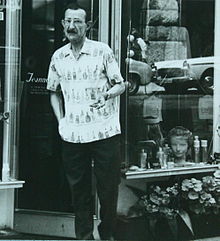Georges Spiro
Georges Spiro (born August 10, 1909 in Warsaw , † 1994 in Nice ) was a Polish-French painter who is assigned to Surrealism .
Life
Due to the separation of his parents, Spiro grew up with his uncle in Vienna . As the best draftsman in his high school class, he refused in 1923 to design a poster for a German national organization. After threats from the drawing teacher, he had to give in, but made fun of German Teutonism. After he was no longer allowed to attend an Austrian grammar school, he applied to Alfred Roller at the Kunstgewerbeschule Vienna , where he was accepted without an examination. In 1926 he was initially a student of Franz Cizek , a pioneer of creative art education and preoccupation with children's drawings. Spiro entered Carl Witzmann's class to study interior design and furniture making. He completed his training as a cabinet maker with the master's examination. In 1927, Sprits uncle lost his fortune due to inflation and currency reform and could no longer finance his nephew's studies. Spiro had to finish his studies and earn a living. He initially changed jobs every three months and worked as a reporter. He outlined the celebrities who visited Vienna, including Josephine Baker , Primo Carnera , Arne Borg , etc.
He worked as a journalist until 1934, but also wrote poems, novels and novels and began to become known as a writer. With his friend Ernst Schönwiese , program director for literature and radio plays at Austrian Broadcasting, he published the literary magazine "Das Silberboot". After the annexation of Austria in 1938, Spiro was arrested by the Gestapo. After his release he fled to France and reached Paris on July 14th. He then lived with his wife and mother in Besançon , where he made wooden toys . He served in the French army at the end of August 1939 in order to obtain French citizenship. He moved into World War II in the 146th Infantry Regiment. In 1940 he left the military and moved to the Lot-et-Garonne department , where he and a Parisian friend in Monclar resumed the manufacture of wooden toys. When he specialized in wooden soles, Spiro left the company.
In 1942 Spiro moved to Nice and began producing children's toys for the third time in collaboration with a furniture manufacturer. He devotes his free time to art - he makes gouaches . During the Second World War , Spiro became a staff sergeant in battalion 21 / XV of the French army and took part in the Italian campaign. After his wife was murdered in a concentration camp, Spiro was able to see his brother again in London in 1946, who had survived the Buchenwald concentration camp for 14 months and emigrated to London.
His gouaches were exhibited for the first time at L'Arcade Gallery, London. The success of the exhibition led Spiro to devote himself exclusively to art. In 1948 Sprio traveled back to France and received the Prix Muratore at the L'Exposition de la Jeune Peinture. This is followed by exhibitions in Paris (Galeir Drouant-David), Stockholm and Gothenburg (André Verdet), Bern, Basel, Berlin, Cannes, Nice, Montreal, Miami and New York (Rudolphe Gallery). In 1952, Dior de la Souchère, curator of the Museé Grimaldi in Antibes, bought some of Spiro's works at the Revue Surrealiste. Six years later, at the Biennale de Menton, Spiro received third prize.
Spiro lived in Nice with his second wife Jeanne, b. Fiolic from Vienna. He had a long friendship with Jean Cocteau .
literature
- P. Cailler: Georges Spiro. Geneva 1959.
- E. Benezit: Dictionnaire critique et documentaire des peintres, sculpteurs, dessinateurs et graveurs, tome 9. Librairie Gründ, Paris 1976.
- Jean-Louis M. Monod, Georges Spiro in Du surréel au fantastique - Préface de Marcel Schneider - Editions Alain Lefeuvre - Nice 1980
- G. Schurr: Le Guidargus de la peinture. Les éditions de l'amateur, Paris 2000.
- Axel Hinrich Murken, Georges Spiro in Fantastic Worlds: From Surrealism to Neo-Symbolism - Three generations of painters of the 20th century. Murken-Altrogge Publishing House, Herzogenrath 2009
Web links
- Arnot Galleries New York (English)
- Biography at www.mecenarts.com (English)
| personal data | |
|---|---|
| SURNAME | Spiro, Georges |
| BRIEF DESCRIPTION | Polish-French painter who is assigned to Surrealism |
| DATE OF BIRTH | August 10, 1909 |
| PLACE OF BIRTH | Warsaw |
| DATE OF DEATH | 1994 |
| Place of death | Nice |
